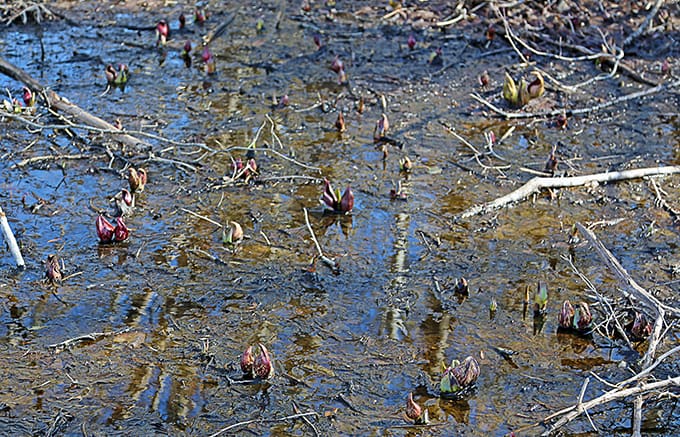Name: Symplocarpus foetidus, aka Skunk Cabbage
Type of Plant: A low growing bog or wetlands plant in eastern North America.
Why I Love/Hate this plant: This plant is a marvel of a plant designed for survival. First of all, skunk cabbage flowers appear in March before most other plants begin to break dormancy. Secondly, one reason they are able to poke through ice and snow in March wetlands is that this is one of the few plants that can generate heat. It’s a plant that is totally designed for taking advantage of its environment and for getting the jump on the competition. From that heat-generation and flowering before other plants bloom, to the fact that it smells like rotting meat (hence the name skunk cabbage) which attracts the pollinators to its flowers. The male parts of the plant lay underneath the female, which increases the possibility that that an insect will take pollen from the male parts of one plant and deposit it in another plant; such cross pollination makes for a stronger species of plants.
After fertilization the seeds form and ultimately grow heavy, lying down on the ground where they can germinate and grow. Leaves emerge in early spring, becoming large and producing energy that is stored in deep roots until next flowering season. And once the summer is hot and dry, the entire plant will disappear back into the marsh, having stored carbohydrates in the extensive root system that can be used next year for generating warmth and flowering once again.
If you live in the northeast, walk in swampy places now and look carefully for the alien-like flowers.
A Word to the Wise: Don’t take the common name of “skunk cabbage” to mean that this plant is edible. It isn’t.

Sometimes skunk cabbage flowers are creamy color or tan speckled with red.

Other times the flowers are dark burgundy in color.

Look for skunk cabbage in bogs or marshlands.

OK…I admit that this photo was primarily of the lovely ferns that were unfurling in and among the skunk cabbage in Sandwich, MA. But look to the right side of the photo, and you’ll see how the fresh, large leaves of the Symplocarpus foetidus look in late April.


0 Comments